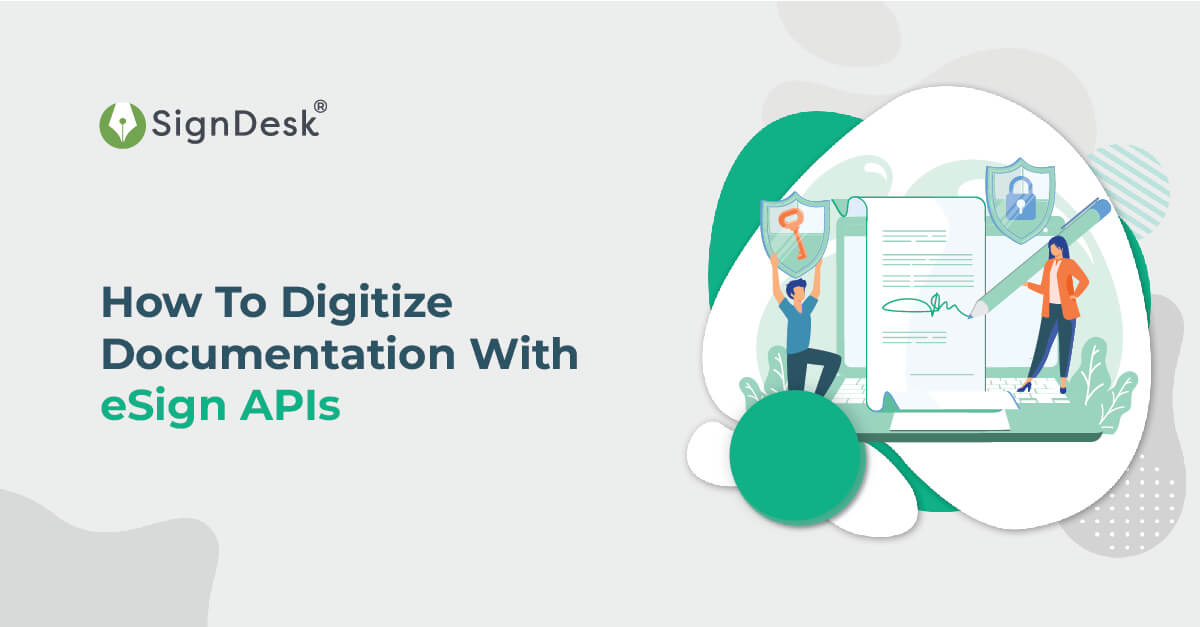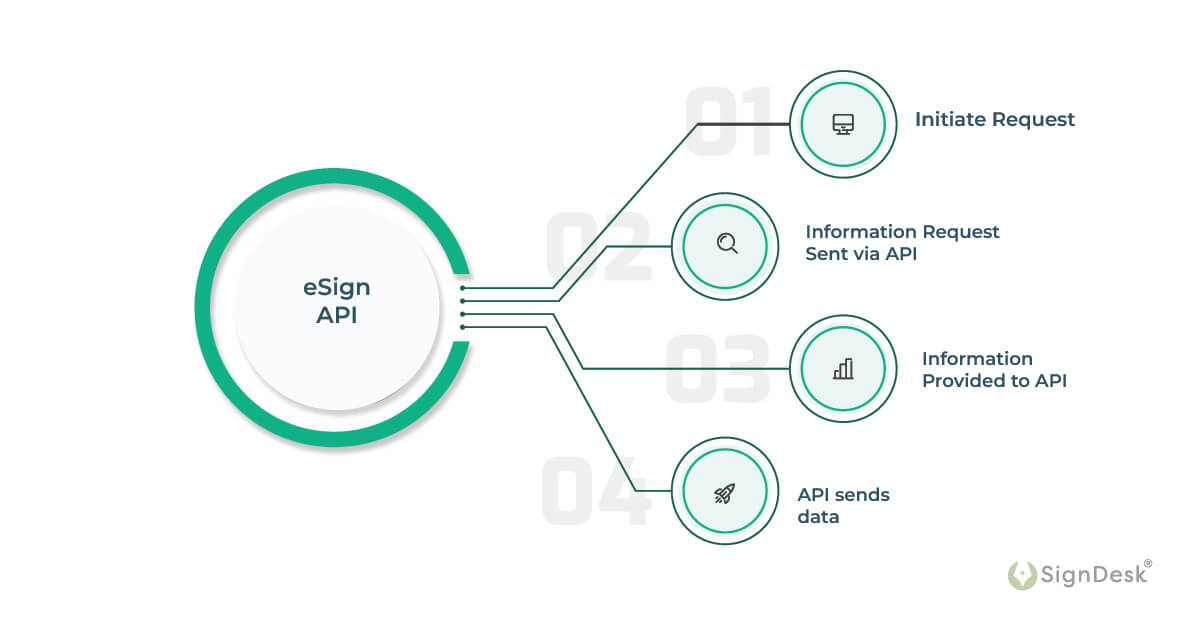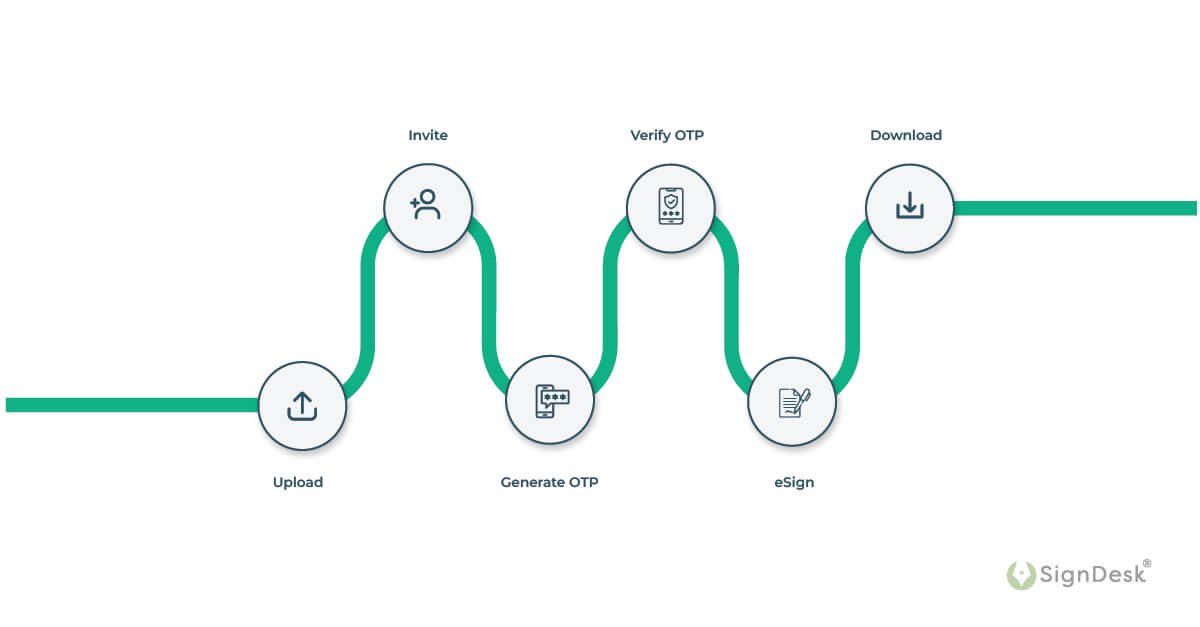What is an E Signature?

An electronic signature, often known as an esignature, is the digital version of a wet ink signature. These signatures are specific to the document, which all parties must sign and validate. Electronic signatures with the help of esign API are simple substitutes for written signatures that make signatures quicker and more secure.
E signatures are a simple and fast way to execute any official agreement. Verifying a document is as simple as inputting an OTP obtained through email or mobile phone from the signer. When an agreement is electronically signed, data about the signers, their location, IP addresses, and notes are all saved in order to verify the integrity of the signed document later.
An eSign API is a convenient option for businesses to undertake eSignatures smoothly and with minimal friction.
The Indian Contract Act and the Information Technology Act, of 2000 govern the legitimacy of electronic signatures in India.
Section 2(1)(a) defines an “electronic signature,” which includes a digital signature, as a subscriber’s means of authenticating an electronic record using the electronic methods indicated in the Second Schedule.
Section 3 of the Information Technology Act of 2000 permits electronic record validation procurement.
eSign or electronic signatures are digital signatures that can be applied to electronic documents, according to Section 5 of the Information Technology Act 2000, which specifies the legal recognition of electronic signatures. All esignatures must be accompanied by a valid acknowledgment.
What is an esign API?
APIs or Application Programming Interfaces help companies and developers to utilize and allow third-party developers and apps to connect to and use their data and capabilities. APIs lay the framework for regulating how one program communicates with another by establishing precisely defined sets of rules.
An eSignature API is a specific type of API that can be used to create eSignatures on documents by communicating with a signature system.
The interface may be viewed as a service contract between two programs. This contract specifies how the two will communicate with one another via requests and answers. Their API description explains how developers should organize such calls and answers.
Client and server are commonly used to describe API architecture. The program that sends the request is known as the client, and the application that sends the answer is known as the server.
When an API is utilized, four critical stages occur to allow the required functionality:
- The user initiates the “request” or retrieval of information.
- The information request is sent to the third-party application.
- The third-party application provides the desired information to the API.
- The API then sends the requested data to both the server and the requesting user.

There are various types of APIs, the most prevalent of which are REST APIs, Soap APIs, and RPC APIs. Each of these API types has a distinct architectural framework for sharing information when and how.
Types of APIs
APIs, especially esign API can function in four ways, depending on when and why they were built.
- Soap APIs
These APIs make use of the Simple Object Access Protocol. XML is used by both the client and the server to exchange messages. This is less versatile in terms of online signature API that was formerly more common.
- RPC APIs
These APIs are referred to as Remote Procedure Calls. The client performs a function (or operation) on the server, and the server returns the result to the client.
- REST APIs
These are the most popular and adaptable APIs available on the web today. As data, the client makes requests to the server. This client input is used by the server to initiate internal activities and delivers output data to the client.
- Websockets APIs
Another current web API development that uses JSON objects to convey data is Websocket API. A WebSocket API allows client apps and the server to communicate in both directions. Callback messages may be sent by the server to connected clients, making it more efficient than REST API.
Features & Use Cases for eSign API
Many nations now permit the use of an online signature API solution to assist businesses and other organizations in completing documents swiftly and avoiding the danger of data loss and other undesirable incidents. Extra costs like pens, ink, printing, storage, and delivery can be eliminated. Due to these reasons, the usage of electronic signature API has been on the rise.
Businesses may capture signatures on documents directly through their website or application by using a free e sign API. Such software also offers a tiered authentication method, which includes downloading the sealed document while simultaneously monitoring the document’s progress in real-time, end-to-end.
Developers may utilize e sign API to make API calls that allow businesses to deliver and sign PDFs from inside their own apps, as well as execute other important operations. For example, e sign API can be used to save time and effort on routine activities. These responsibilities include acquiring vital documents and agreements from personnel. Instead of having to individually communicate with and acquire papers from each employee, esign API may be used to automate the signature process in seconds.
eSign API offers a variety of features to streamline signature cycles and help businesses increase documentation capacity.
- Workflow Building Blocks: Leverage configurable workflows to create custom online signature API processes that merge multiple documents into a single signature workflow
- Group Signatures: Create signer groups & invite these groups to eSign documents all at once
- Bulk Signature Capabilities: Upload multiple documents for signature and get them all eSigned on the go in minutes
- Pre-Signature Authentication: Utilize face match and video recording workflows to ensure signer authenticity
- Configurable OTP & SMS: Text-to-speech technology enables voice OTPs; additionally, international SMS configurations allow for signatures from anywhere in the world
- Widget Integrations: eSign documents directly in the application I-frame without leaving the app; alternately, redirection APIs take clients from email to the signature portal
How Does an eSign API Work?
SignDesk provides a versatile, low-code e Sign API that allows organizations to optimize and accelerate their document signature procedures. The API is scalable, and organizations can quickly integrate it into their esignature infrastructure without fear of disrupting processes.
Customers may sign documents more easily using esignature APIs since they do not have to show themselves on-premise via simple steps:

- Step 1: The user generates or uploads a document to be signed.
- Step 2: The user sends an online eSignature invitation to the signer.
- Step 3: The signer receives the invitation through email or mobile phone.
- Step 4: The signer logs in and fills in the information requested on the eSignature platform.
- Step 5: The API checks the user’s identity against the databases to guarantee its legitimacy.
- Step 6: An OTP is sent to the signer’s registered mobile number or email address.
- Step 7: On the online eSign platform, the signer inputs the OTP obtained on his device.
- Step 8: If the signer enters the right OTP, the eSignature on the uploaded document is performed.
- Step 9: After the transaction is completed, both parties can download the document.
eSign API – Why Do Businesses Need Faster Signatures?
Online signature APIs may be used in an infinite number of ways by developers and companies. While demand and industry-specific demands dictate utilization and implementation.
Most businesses profit from the same things, which drives the demand for additional API solutions.
- Increased value by delivering significant extra functions to clients
- Reduced costs by reducing the time and effort required to create new apps and relying only on third-party APIs.
- Access to APIs enables faster and better innovation by meeting consumer and corporate demands, implementing changes, and maintaining relevance.
- Improved team collaboration by connecting items like communication applications, Customer Relationship Management (CRM) software, eSigning apps, and more utilizing APIs.
- Improved customer experiences through the use of APIs to swiftly and efficiently link consumers to in-demand tools and capabilities.
- Improved productivity for teams and developers by simplifying and improving daily procedures by linking users to the apps they require.
- According to e signature legislation, any document bound with an e-sign has the same legal effect as a document with a wet-ink signature.
- E signatures provide a few extra security advantages. Bank-level encryption is used to guarantee confidentiality and biometric signatures to instantaneously disclose the signer’s identity. The papers cannot be jumbled or tampered with, and if they are, the sender will be notified immediately.
Using esignatures is just one more step toward your objective. Going paperless would benefit the environment and be incredibly cost-effective and easy for any company.
eSignature APIs Digitize Signatures Across Industry Sectors
Businesses have been able to minimize the time it takes to execute a contract from 10 to 20 days to under 10 minutes when signing a PDF online, thanks to SignDesk’s esignature workflow and document management technology, Ink.It.
Signers may rapidly eSign PDF files using online eSign services and templates, with our sophisticated management software keeping track of all corporate documents.
Esignature APIs have been leveraged by several industries in their workflow and operations.
- Financial Institutions
On a daily basis, banks, NBFCs, and financial institutions handle millions of papers such as agreements, permission forms, mandate forms, and sanction letters.
SignDesk’s esignature software with online signature APIs and eSign workflow may be connected to any bank’s loan authorization, cheque truncation, CRM, or ERP processes to allow digital documents to be prepared, signed, and maintained digitally; this decreases the time it takes to execute a document to less than 10 minutes.
- Legal
Paper papers obstruct legal companies more than any other sector. Documentation is perhaps the most significant aspect of any legal transaction, and businesses spend days preparing, negotiating, and executing legal contracts.
Legal teams across industries produce agreements and contracts on a vast scale. Legal teams may use Aadhaar eSign with templatization tools to design, approve, negotiate, and execute agreements on a single platform.
SignDesk’s eSign system also generates a robust audit trail and includes signer verification tools to assist legal teams in ensuring compliance and doing due diligence.
- Retail
To be successful, businesses in the retail and FMCG sectors must be quick and effective. Vendor agreements must be created rapidly, sent to suppliers quickly, and signed even faster.
When it comes to agreements, eCommerce and retail shops also require contracts to be signed, and eSign may make the entire process smoother between the seller and the buyer. While shops must deal with several providers at once to maintain seamless operations, a digital signature helps to streamline the entire process.
- Healthcare
Healthcare organizations may employ specialized eSign methods to automate the majority of their documentation, freeing them more time for patient care. For healthcare institutions to prepare agreements and patient forms in mass, eSign based documentation systems offer a wide selection of templates.
The templates include pre-authorization documentation, medical claims forms, personalized prescription slips, and other documents.
When a medical document is created online, it is digitally authenticated by all parties involved before being sent to all necessary stakeholders for esignatures.
- Insurance
Using an electronic signature system and an automated eSign approach, insurers may swiftly prepare policy papers and eSign insurance documents.
Insurers may use huge template libraries to generate insurance papers, ask numerous healthcare providers, hospital management, and executives to electronically sign these documents, and manage them all from a smart dashboard.
A better customer experience may assist firms to enhance user loyalty and raise the likelihood of customer referral.
Schedule a demonstration with one of our eSign specialists and utilize the eSign platform to understand how to implement SignDesk’s Aadhaar e signature API into your documentation workflow.